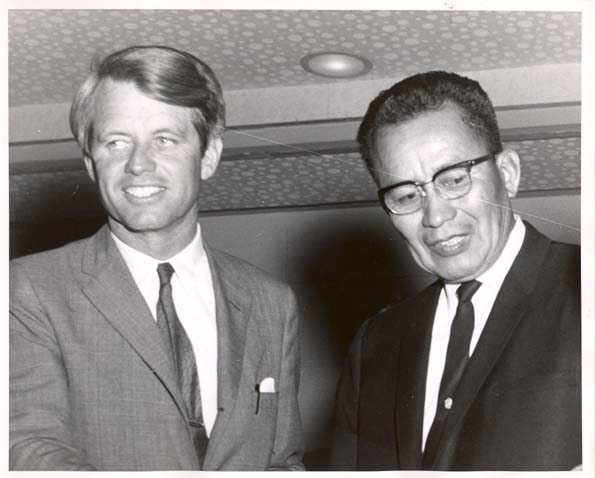
50 Years Ago: Nakai campaigns to re-elect LBJ

Raymond Nakai and Robert Kennedy in about 1960. Image courtesy of Navajo Nation.
ABOVE: Raymond Nakai with Robert Kennedy in about 1960.
WINDOW ROCK – The race for president of the United States is heating up and it seems that the Navajo Tribe is finding itself caught in the middle, in part because of the decision by the tribe’s chairman, Raymond Nakai, to do everything he can to get Lyndon B. Johnson re-elected.
This week Nakai was in Santa Fe for a major Democratic rally in which the vice presidential nominee for the Democratic Party, Hubert Humphrey, was the main speaker.
Nakai said the poverty programs established during the Kennedy and Johnson administrations already are helping thousands of members of the Navajo Tribe and under the Democrats, there has been a renewed program of building schools and public housing.
The Republican platform, he said, totally ignores the needs of the Navajos.
According to media reports from those times, Johnson’s opponent, Barry Goldwater, wasn’t happy with Nakai’s remarks, pointing out that he has always been a champion of the Navajo people and willing to do anything for their well-being.
He said his family has a long history of working with the Navajos as traders and as public servants both in the state and in the federal government.
“I know the Navajo people and the Navajo people know that I am their best friend when it comes to getting programs and federal funds to help them out,” Goldwater said.
Polls, however, showed Johnson way out in front of Goldwater in Indian Country and even on the Navajo Reservation.
But Navajo Republicans were not going to give up without a fight.
Daniel Peaches, one of Goldwater’s most vocal supporters, wrote a letter to the Navajo Times, pushing Goldwater’s credentials.
“Sen. Goldwater is deeply interested in Indian culture and heritage,” Peaches wrote. “He admires their courage in the face of hardship which is their lot even at the present time.”
Goldwater also, Peaches said, gave his hilltop home in Phoenix a Navajo name.
“The philosophy of Goldwater, in many respects, is similar to the philosophy of American Indians,” he wrote.
“These are mainly: self-reliance, individual responsibility, moral and physical courage and a belief in the spirit of man. These are the cornerstones of individual freedom on which democracy thrives,” he wrote.
Peaches’ mention of the Smoki Clan back in 1964 probably didn’t raise many eyebrows on the Navajo Reservation but by the late 60s and early 70s, the group would come under heavy criticism from traditional leaders on the Hopi Reservation.
The group was formed in 1921 by several prominent businessmen in Prescott and politicians who said they wanted to honor Native culture by dressing in Indian regalia and doing simulations of Hopi and Zuni religious dances during the Prescott Frontier Days rodeo.
The dances were a hit with the rodeo crowd and the group, according to an article in the Prescott Courier in 2010, “dominated Prescott’s social scene for the next 70 years.”
The Hopi traditionalists said they found the dances offensive and added that others should not try and imitate their sacred dances.
But leaders of the group argued that they were not trying to ridicule the Hopis but to honor them.
The protests kept getting bigger and bigger in the 1970s and 1980s to the point where every time the group did its dances, the stories in the media would focus on the protests and not the dances.
Finally, in 1989, the leaders of the group decided to tackle the controversy head-on and invited leaders of the Hopi, Zuni, Navajos and other tribes in Arizona to come and watch the dances themselves and decide whether the dances were being done in poor taste.
That turned out to be a bad mistake.
“Once the antelope dancers were assembled in the rodeo arena, the snake dancers emerged with bull snakes clinched in their mouths,” according to the Courier.
“The 100 Native Americans in the visiting delegation at first watched in ‘stunned awe,’ but then began laughing at the antics of the white men and women chanting and dancing around the arena,” the article stated.
Within two years, the group disbanded, in part because members could not take the constant criticism in the papers and partly because interest in the group dropped, going from a high of 400 members in the 1920s to 100 by 1991.
But the Smokis live on, sort of, within the Smoki Museum located in Prescott, which displays relics from the days of the Smoki Clan along with authentic Indian arts and crafts.








 Highway 264,
Highway 264, I-40, WB @ Winslow
I-40, WB @ Winslow